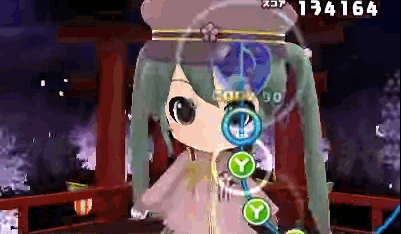Get ready for a shock if you still think pop stars need to be made of flesh and blood.
Years ago, Yamaha developed Vocaloid, musical software that lets computers sing with synthesized voices. In 2007, that software got a body, and its name is Hatsune Miku. (That's pronounced hot-sue-neigh mi-koo.) She's a blue-haired anime girl who tours the world for live, human people, appearing as an ethereal hologram onstage, belting out digital music written in Vocaloid software by her own adoring fans. In the years since her introduction, she's been joined by a troupe of other Vocaloid singers, both male and female, and she's starred in several video games.
The whole thing is astonishingly bizarre and perhaps the most significant thing to happen in pop music since Madonna humped the VMAs stage in her wedding dress.

Hatsune Miku's Vocaloid friends as portrayed in "Hatsune Miku: Project Mirai DX" for the Nintendo 3DS.
It's a perfectly 21st-century idea. Here's a digital pop star whose songs are all crowd-sourced. Miku doesn't need to worry about losing her voice or spraining her ankle onstage. You could call her the face of soulless corporate entertainment, but she exists because her fans will her to, which totally flips the equation. They give her the music and cheer her on at concerts.
Put another way, if everyone woke up and decided they hated Miku tomorrow, a computer program would go unused. That's not so sad. If the same thing happened to Taylor Swift, she'd release mediocre albums for decades to diminishing returns and be the second opener for Demi Lovato. That's very sad.
Jarring as this may be to those of you who didn't realize singing Japanese holograms walked the Earth -- let alone opened for Lady Gaga -- Hatsune Miku is actually pretty well-established. Thousands pack arenas for her concerts. She's been on Letterman. Google licensed one of her songs for an advertisement in Japan, and she's officially endorsed Domino's pizza. Talking about her weirdness is truthfully a bit like chomping down on a hunk of wasabi and calling it spicy -- sure, but what else?
The "what else" is video games. On Tuesday, Sega released "Hatsune Miku: Project Mirai DX" for the Nintendo 3DS. It's far from the first Hatsune Miku game, but it's maybe the best look into her world yet -- a $40 ticket to understanding what, exactly, everyone loves about this breed of Vocaloid singer.
The game won't necessarily be the same thing for everyone. When you boot it up, you'll choose the little anime hologram singer you identify with most. You'll spend time decorating his or her house, choreograph dance moves, tap your stylus to the rhythm of his or her songs and, uh, take photographs of him or her posing near furniture. You can compose music with your Vocaloid and give him or her an allowance to spend on things like new kimonos or teddy bears. The two of you can play Reversi together.
In other words, the whole thing is incredibly personalized, just like the realer-life Vocaloid singers are. There's an infectious, positive vibe that managed to hook even this avowed fan of sludge metal music -- and I'll tell ya, "Waste of Tiamat" by High on Fire is a far cry from Miku's "Romeo and Cinderella."
To find out more about "Project Mirai DX" and the Vocaloid phenomenon, The Huffington Post spoke with Sam Mullen, the localization producer at Sega who helped bring the game overseas for American audiences.

So, this is a game about dressing up and hanging out with anime characters who sing synthesized songs in Japanese. I feel like this must have been a challenge to adapt for a U.S. audience.
There are some challenges. A lot of the content surrounding "HatsuMiku" is very Japanese-centric. There's a lot of J-pop. But we also recognize that the fans of Miku and Vocaloids like Japanese stuff in general. We don't concern ourselves with overtly Westernizing anything. We do try to strike a balance.
How would you describe the culture around Vocaloid music and concerts to someone who's completely uninitiated? These characters fill bigger venues than the bands I like and they're animated projections.
Everything is essentially generated by the crowd. Some people refer to it as a Wiki-celebrity. She is what you make her to be. Because of that, most of the content is basically provided by the crowd. The songs are provided by the crowd. The costumes are designed by netizens, people on art-sharing sites. The music in "Project Mirai DX" is created by third-party artists and whatnot. Very little is made by Sega. Sega takes what the most popular stuff is and what's resonating within the community and takes it within the game to turn a mirror onto the community.
Tell me more about that.
It's what goes viral on the Internet. People get popular doing their thing. It's on [Japanese video site] NikuNikuDouga or YouTube. It's whatever rises -- the cream of the crop. When Sega is looking at making these games, generally what happens is the team comes up with a theme. They don't just pick up random stuff. A great example, in a previous game, in "Project Diva F 2nd," it's supposed to be a compilation of older, classic Miku stuff and newer Miku stuff. It's half and half. For "Mirai DX," they're focused on music that spans the entire breadth of Miku's discography. Like "World Is Mine," that's a classic. And there's more recent stuff, stuff that Sega built for this particular game -- the theme song, "Nice To Meet You Mr. Earthling."
It's a great opportunity to bring it out West. It's the ultimate compilation.
When you're playing through the U.S. game's "Guitar Hero"-like rhythm mode, it displays the original Japanese lyrics spelled out in English letters. That's cool if you want to sing along, but I found myself wondering what the lyrics actually meant. Can you talk about how you approached that issue?
All this music -- none of it is owned by Sega, essentially. We're at the whims of the artists. The artists are like our customers. We treat their works with utmost respect. When we do this Romanization, this transliteration of the lyrics, it's very simple. It's either correct, or it's not.
Translating lyrics from Japanese in English is actually extremely difficult. There's a lot of wordplay and nuance, stuff you can do in Japanese that you can't actually replicate in English. Honestly, it can be very interpretive and very subjective. The songs are generated by the crowd, so the meanings of the lyrics, you can interpret them 100 different ways.
So, I'm actually a metalhead, but I'm really into the song "Sweet Magic" that's in the 3DS game. That was the one that hooked me.
This is key to the Miku-Sega thing. Exactly what you're going through right now. Probably about 95 percent of the people who pick up one of these Miku games and play, they go through this process themselves. I remember playing through my first Miku game and looking at it, and at first I was kind of like, I don't know how I feel about this music. But then I hit upon one song I loved. Then I was like, this one, too. Then another. This discovery process, you may not feel it at first, but as soon as you find that one song, it links into more and more content, and now we have tons of games for people to play. People discover Vocaloid stuff through these games.
Obviously this isn't really a dating sim, but it has some of those elements -- you're "hanging out," you're buying gifts for your Vocaloid, you're giving her an allowance. Is this game meant to appeal to a certain gender or age group?
I don't think the intention is to appeal to a certain age group. Ultimately, it does involve decking out their house or giving them presents, but the goal here is to take this virtual character, this character that only exists in our minds -- Miku is not a physical being walking around. She's purely a figment of our imagination and a representation of our creativity. The thing about these games is that they give you this opportunity or mechanism for these characters to come and live and exist for you. Whether it's watching them play "Virtua Fighter" or watch her run on a treadmill and run off.
I like playing Mikuversi, the sort of Reversi game. I get a kick out of watching her get backed into a corner and frustrated. It's not just you versus a CPU, it's a character.
Anything else?
Miku is a rabbit hole. It's very deep. For most people who become fans of [Hatsune Miku], these games are the touch point. This is the first experience many will have with [her]. And I think "Project Mirai DX" is one of the best games to date.
This interview has been edited for clarity and length.
